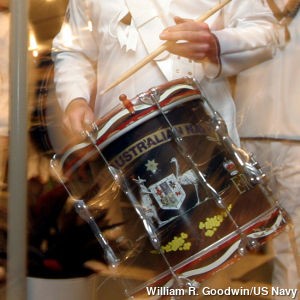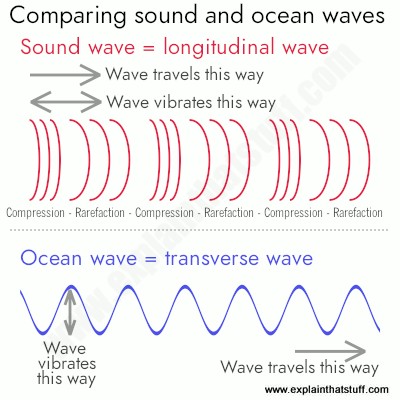Sound waves travel through the air. Are you curious about the science behind this everyday phenomenon? With SIXT.VN, your trusted travel companion in Vietnam, we aim to provide insights into the world around you, just like we provide seamless travel experiences. Let’s dive into the fascinating world of acoustics and explore how sound propagates.
1. What Exactly Are Sound Waves, and How Do They Start?
Sound waves are pressure disturbances that travel through a medium, typically air, created by a vibrating object. These vibrations cause air molecules to move, creating compressions and rarefactions that propagate outward. According to research from the Acoustical Society of America, in 2020, the human ear can perceive sound waves with frequencies ranging from 20 Hz to 20,000 Hz. SIXT.VN is dedicated to ensuring your travels are as clear and smooth as the sound waves we’re about to explore, by providing top-notch travel and tourism information.
1.1. Vibrations: The Genesis of Sound
Vibrations are crucial to creating sound. When an object vibrates, it disturbs the surrounding air molecules. These disturbances propagate as sound waves.
- Simple Harmonic Motion: Many vibrating objects, like a tuning fork, exhibit simple harmonic motion, creating a pure tone.
- Complex Vibrations: Musical instruments and voices produce complex vibrations, resulting in rich and varied sounds.
1.2. Mediums of Transmission: More Than Just Air
While air is the most common medium, sound can also travel through solids and liquids.
- Solids: Sound travels faster in solids due to the close proximity of molecules.
- Liquids: Sound travels slower in liquids than in solids but faster than in gases.
 A marching navy drummer hits a drum with his sticks
A marching navy drummer hits a drum with his sticks
2. How Do Sound Waves Travel Through Air: A Detailed Explanation?
Sound waves travel through the air via a process of compressions and rarefactions, creating a longitudinal wave pattern that propagates outward from the source. Sound waves are mechanical waves, meaning they require a medium to travel, such as air, water, or solids.
2.1. Compressions and Rarefactions: The Wave’s Building Blocks
Compressions and rarefactions are essential to sound wave propagation. These alternating regions of high and low pressure allow sound to travel through a medium.
- Compressions: Regions where air molecules are tightly packed together, creating high pressure.
- Rarefactions: Regions where air molecules are spread apart, creating low pressure.
2.2. Longitudinal Waves: Understanding the Movement
Sound waves are longitudinal waves, meaning that the movement of the particles is parallel to the direction of energy transfer.
- Particle Motion: Air molecules vibrate back and forth in the same direction as the wave’s movement.
- Energy Transfer: The energy of the sound wave is transferred through the medium via these molecular vibrations.
2.3 Sound waves travel outwards
As sound waves travel outwards from the source, they spread out spherically. The intensity of the sound decreases as the distance from the source increases.
- Inverse Square Law: The intensity of the sound is inversely proportional to the square of the distance.
- Absorption: Air and other mediums can absorb sound energy, further reducing the intensity over distance.
2.4. Factors Affecting Sound Travel in Air
Several factors can affect how sound waves travel through the air. The properties of the air itself, such as temperature, humidity, and density, play a significant role.
- Temperature: Sound travels faster in warmer air because molecules move more quickly.
- Humidity: Increased humidity can slightly increase the speed of sound.
- Density: Higher air density can affect sound wave propagation.
3. What Are Longitudinal and Transverse Waves and Their Differences?
Longitudinal waves, like sound waves, involve particle motion parallel to the wave direction, creating compressions and rarefactions. Transverse waves, such as light waves, involve particle motion perpendicular to the wave direction, creating crests and troughs. SIXT.VN understands that navigating travel details can feel like understanding wave mechanics, but we’re here to simplify your journey.
3.1. Longitudinal Waves: Sound’s Mode of Transport
Longitudinal waves are characterized by their particle motion parallel to the wave direction.
- Compressions and Rarefactions: As discussed earlier, these are the hallmarks of longitudinal waves.
- Examples: Sound waves are the most common example, but other examples include seismic P-waves.
3.2. Transverse Waves: A Different Kind of Vibration
Transverse waves involve particle motion perpendicular to the wave direction.
- Crests and Troughs: These are the high and low points of a transverse wave, respectively.
- Examples: Light waves, water waves, and seismic S-waves are examples of transverse waves.
3.3. Key Differences: Motion and Medium
The key differences between longitudinal and transverse waves lie in their particle motion and ability to travel through different mediums.
| Feature | Longitudinal Waves | Transverse Waves |
|---|---|---|
| Particle Motion | Parallel to wave direction | Perpendicular to wave direction |
| Medium | Can travel through solids, liquids, and gases | Can travel through solids and some liquids; not gases |
| Examples | Sound waves, seismic P-waves | Light waves, water waves, seismic S-waves |
| Characteristics | Compressions and rarefactions | Crests and troughs |
 A line artwork comparing longitudinal sound waves and transverse ocean waves.
A line artwork comparing longitudinal sound waves and transverse ocean waves.
4. What is the Speed of Sound, and What Affects It?
The speed of sound is the distance sound travels through a medium in a given amount of time, typically around 343 meters per second in dry air at 20°C (68°F). According to the National Aeronautics and Space Administration (NASA), in 2023, the speed of sound varies depending on the medium’s properties. Factors like temperature, density, and elasticity significantly influence it.
4.1. Factors Influencing the Speed of Sound
Several factors affect the speed of sound in different mediums.
- Temperature: As temperature increases, the speed of sound increases.
- Density: As density increases (in gases), the speed of sound decreases. In solids, higher density often leads to higher elasticity, increasing the speed of sound.
- Elasticity: Higher elasticity (stiffness) allows sound to travel faster.
4.2. Speed of Sound in Different Mediums
The speed of sound varies significantly depending on the medium through which it travels.
| Medium | Speed of Sound (m/s) |
|---|---|
| Air | 343 |
| Water | 1,481 |
| Steel | 5,960 |
| Diamond | 12,000 |
4.3. Practical Implications of Sound Speed
Understanding the speed of sound has practical implications in various fields.
- Acoustics: Designing concert halls and recording studios requires precise knowledge of sound speed.
- Navigation: SONAR uses sound speed to calculate distances underwater.
- Aerospace: Understanding sound speed is crucial for designing supersonic aircraft.
5. How Does Sound Reflection (Echo) Work?
Sound reflection, or echo, occurs when sound waves bounce off a surface and return to the listener. The time it takes for the echo to return depends on the distance to the reflecting surface. This phenomenon is used in various applications, including SONAR and echolocation.
5.1. The Science Behind Echoes
Echoes are produced when sound waves encounter a barrier and reflect back.
- Reflection Angle: The angle of incidence equals the angle of reflection, similar to light.
- Surface Properties: Smooth, hard surfaces reflect sound more efficiently than rough, soft surfaces.
5.2. Applications of Sound Reflection
Sound reflection has numerous practical applications.
- SONAR: Used by ships and submarines to detect underwater objects.
- Echolocation: Used by bats and dolphins to navigate and find prey.
- Acoustic Design: Used in architecture to optimize sound quality in concert halls and theaters.
5.3. Experiencing Echoes in Daily Life
Echoes can be observed in various everyday situations.
- Canyons: Yelling in a canyon produces a distinct echo due to the large, reflective surfaces.
- Empty Rooms: Empty rooms often have noticeable echoes due to the lack of sound-absorbing materials.
- Large Buildings: Cathedrals and large halls can produce echoes due to their size and reflective surfaces.
Picture: Reflected sound is extremely useful for “seeing” underwater where light doesn’t really travel—that’s the basic idea behind sonar. Here’s a side-scan sonar (reflected sound) image of a World War II boat wrecked on the seabed.
Alt text: Sonar image of a World War II patrol boat wreck, illustrating the use of reflected sound in underwater detection.
6. What Are Whispering Galleries and Amphitheaters?
Whispering galleries are structures with curved surfaces that concentrate sound waves, allowing whispers to be heard clearly across long distances. Amphitheaters use similar principles to project sound effectively to large audiences. These architectural marvels demonstrate the principles of sound reflection and focusing.
6.1. How Whispering Galleries Work
Whispering galleries utilize curved surfaces to focus sound waves.
- Curved Surfaces: Domes or curved walls reflect sound waves towards a specific focal point.
- Sound Focusing: Whispers spoken at one point can be heard clearly at another distant point.
6.2. Famous Examples of Whispering Galleries
Several famous structures utilize the whispering gallery effect.
- St. Paul’s Cathedral, London: Known for its impressive whispering gallery in the dome.
- US Capitol, Washington D.C.: Features a whispering gallery that allows for unique acoustic experiences.
- Grand Central Terminal, New York City: Has a whispering gallery in its lower level.
6.3. Amphitheaters: Sound Amplification in Open Spaces
Amphitheaters are designed to project sound effectively in open spaces.
- Curved Seating: The curved seating arrangement reflects sound towards the audience.
- Stage Design: The stage is designed to amplify and project sound efficiently.
- Natural Acoustics: Amphitheaters often use natural acoustics to enhance sound quality.
 US Capitol in Washington DC by Carol M. Highsmith.
US Capitol in Washington DC by Carol M. Highsmith.
7. How Are Sound Waves Measured: Amplitude and Frequency?
Sound waves are measured by their amplitude, which determines loudness, and their frequency, which determines pitch. Amplitude is the intensity of the sound wave, typically measured in decibels (dB), while frequency is the number of cycles per second, measured in hertz (Hz). Understanding these properties is essential for analyzing and manipulating sound.
7.1. Amplitude: Measuring Loudness
Amplitude is the measure of the intensity or loudness of a sound wave.
- Decibels (dB): Sound intensity is typically measured in decibels.
- Loudness Perception: Higher amplitude waves are perceived as louder sounds.
- Examples: A whisper is around 30 dB, while a rock concert can be 120 dB or higher.
7.2. Frequency: Measuring Pitch
Frequency is the measure of the number of cycles per second of a sound wave, determining its pitch.
- Hertz (Hz): Frequency is measured in hertz.
- Pitch Perception: Higher frequency waves are perceived as higher-pitched sounds.
- Human Hearing Range: Humans can typically hear frequencies from 20 Hz to 20,000 Hz.
7.3. Visualizing Amplitude and Frequency
Amplitude and frequency can be visualized using waveforms.
- Waveform Representation: Amplitude is represented by the height of the wave, while frequency is represented by the number of waves per unit of time.
- Oscilloscopes: Devices used to visualize waveforms and analyze sound properties.
8. How Do Musical Instruments Create Different Sounds?
Musical instruments create different sounds by producing unique combinations of fundamental frequencies and harmonics. Each instrument has its own characteristic timbre, which is determined by the relative amplitudes of these harmonics. This complex interplay of frequencies gives each instrument its distinct sound.
8.1. Fundamental Frequency and Harmonics
Musical sounds are composed of a fundamental frequency and a series of harmonics.
- Fundamental Frequency: The lowest frequency produced by the instrument, determining the perceived pitch.
- Harmonics: Higher frequencies that are integer multiples of the fundamental frequency, adding richness and complexity to the sound.
8.2. Timbre: The Unique Sound Quality
Timbre, also known as sound quality, is the characteristic that distinguishes different instruments.
- Harmonic Content: The relative amplitudes of the harmonics determine the timbre of the instrument.
- Examples: A violin and a piano playing the same note will sound different due to their unique timbres.
8.3. Methods of Sound Production
Different instruments use various methods to produce sound.
- String Instruments: Vibration of strings (e.g., guitar, violin).
- Wind Instruments: Vibration of air columns (e.g., flute, trumpet).
- Percussion Instruments: Vibration of solid objects (e.g., drums, xylophone).
9. How Does Sound Travel Faster in Some Materials Than Others?
Sound travels faster in some materials than others due to differences in density, elasticity, and molecular structure. In general, sound travels fastest in solids, followed by liquids, and slowest in gases. These differences are due to how effectively the material transmits vibrations.
9.1. Density and Elasticity
Density and elasticity are key factors affecting sound speed.
- Density: In solids, higher density often correlates with higher elasticity, allowing for faster sound transmission. In gases, higher density reduces sound speed.
- Elasticity: Higher elasticity means the material returns to its original shape quickly after being deformed, allowing for faster vibration transmission.
9.2. Molecular Structure
The molecular structure of a material also plays a significant role.
- Solids: Molecules are closely packed, allowing for efficient vibration transmission.
- Liquids: Molecules are more loosely packed than in solids, resulting in slower sound transmission.
- Gases: Molecules are widely dispersed, leading to the slowest sound transmission.
9.3. Comparing Sound Speed in Different Materials
As shown in the table earlier, sound speed varies significantly across different materials.
- Examples: Sound travels much faster in steel than in air due to its higher density and elasticity.
Chart: Generally, sound travels faster in solids (right) than in liquids (middle) or gases (left)… but there are exceptions!
Alt text: Bar chart comparing the speed of sound in different materials: solids, liquids, and gases.
10. What Are Some Practical Applications of Sound Technology?
Sound technology has numerous practical applications in various fields, including medicine, communication, entertainment, and industry. From ultrasound imaging to noise cancellation technology, sound is used in innovative ways to improve our lives.
10.1. Medical Applications
Sound technology is widely used in medicine.
- Ultrasound Imaging: Used to visualize internal organs and monitor fetal development.
- Therapeutic Ultrasound: Used to treat conditions such as kidney stones and tumors.
10.2. Communication and Entertainment
Sound technology is essential for communication and entertainment.
- Telecommunications: Used in telephones, smartphones, and other communication devices.
- Audio Systems: Used in speakers, headphones, and other audio equipment.
- Music Recording: Used to capture and reproduce music.
10.3. Industrial Applications
Sound technology also has important industrial applications.
- SONAR: Used for underwater mapping and object detection.
- Nondestructive Testing: Used to detect flaws in materials without causing damage.
- Acoustic Sensors: Used to monitor machinery and detect potential problems.
Frequently Asked Questions (FAQ) About Sound Waves
Here are some frequently asked questions to enhance your understanding of sound waves.
1. What is the range of human hearing?
Humans typically hear frequencies from 20 Hz to 20,000 Hz.
2. Why does sound travel faster in warm air?
In warmer air, molecules move faster, transmitting sound vibrations more quickly.
3. What is an echo?
An echo is the reflection of sound waves off a surface back to the listener.
4. How do noise-canceling headphones work?
Noise-canceling headphones use microphones to detect ambient noise and produce opposing sound waves to cancel it out.
5. What is ultrasound?
Ultrasound is sound with frequencies above the human hearing range, used in medical imaging and other applications.
6. What is infrasound?
Infrasound is sound with frequencies below the human hearing range, often produced by natural events like earthquakes.
7. How is sound used in SONAR?
SONAR (Sound Navigation and Ranging) uses sound waves to detect objects underwater by measuring the time it takes for echoes to return.
8. What is the difference between loudness and pitch?
Loudness is determined by the amplitude of the sound wave, while pitch is determined by the frequency.
9. How do musical instruments produce sound?
Musical instruments produce sound by vibrating different materials (strings, air columns, etc.) at specific frequencies.
10. What is the speed of sound in a vacuum?
Sound cannot travel in a vacuum because it requires a medium (like air, water, or solids) to propagate.
SIXT.VN: Your Trusted Travel Partner in Vietnam
Understanding how sound waves travel through the air is just one facet of the fascinating world around us. At SIXT.VN, we aim to provide clarity and ease to your travel experiences, much like understanding the science of sound.
Navigating Your Travel Needs
Planning a trip to Vietnam? Let SIXT.VN be your guide. We offer a range of services to make your journey seamless and enjoyable:
- Airport Transfers: Start your trip stress-free with our reliable airport transfer services.
- Address: 260 Cau Giay, Hanoi, Vietnam.
- Hotline/Whatsapp: +84 986 244 358.
- Hotel Bookings: Find the perfect accommodation with our wide selection of hotels.
- Tour Packages: Explore Vietnam with our curated tour packages, designed to suit every interest.
- Flight Bookings: Get the best deals on flights to and from Vietnam.
- Car Rentals: Explore Vietnam at your own pace by renting a car from SIXT.VN.
Why Choose SIXT.VN?
SIXT.VN stands out as the premier choice for travelers in Vietnam due to our commitment to excellence and customer satisfaction. We provide:
- Convenience: Easy booking and reliable service.
- Trustworthiness: A reputation built on quality and integrity.
- Support: Dedicated customer service to assist you every step of the way.
SIXT.VN is committed to providing you with exceptional travel experiences. Just as sound waves require a medium to travel, let SIXT.VN be the medium that carries you through your journey in Vietnam, making it smooth, clear, and unforgettable.
Visit our website at SIXT.VN to explore our services and start planning your dream trip today! With SIXT.VN, every detail of your travel is taken care of, ensuring a memorable and hassle-free experience.
Explore Vietnam with confidence and ease. Book your travel services with SIXT.VN today



